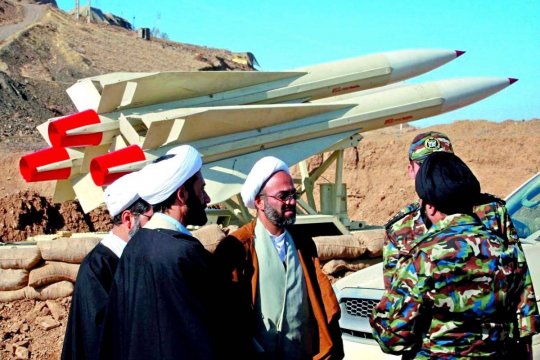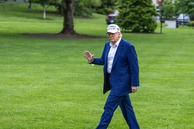On May 8, 2018, President Donald Trump withdrew the United States from the Joint Comprehensive Plan of Action (JCPOA), better known as the Iran nuclear deal, and imposed tough unilateral sanctions on Tehran. Exactly a year later, this move looks dangerously fraught with unpredictable and potentially catastrophic consequences for the Middle East.
Britain, France and Germany, as participants and co-sponsors of the JCPOA, strongly criticized Trump's anti-Iranian policy and, with Russian and Chinese support, they established, registered and set in motion, albeit in a test mode, the Instrument in Support of Trade Exchanges (INSTEX) - a special-purpose vehicle (SPV) to facilitate non-dollar trade with Iran.
Tehran took its time hoping for European support. However, on April 22, 2019, Trump ended waivers that Washington had earlier granted China, India, South Korea, Turkey, Italy, the United Arab Emirates, Japan and Taiwan that allowed these countries to import Iranian oil. A complete ban on the purchase of Iranian crude came into force on May 2, 2019. The United States’ ultimate goal is to stop all Iranian crude exports. Whether this is actually possible is not clear. What is clear, however, is that the US is ramping up economic pressure on Tehran.
Meanwhile, Europe will hardly be able to resist Washington’s sanctions against Iran, which are almost as hard-hitting as the ones that were in effect between 2012 and 2016 when the Iranian economy was going through hard times. Still, the EU’s foreign affairs commissioner Federica Mogherini recently went on record saying that "we will continue to support [JCPOA] as much as we can with all our instruments and all our political will.”
Just how much will the EU really has to resist US pressure is a big question though.
Iran found itself in a real fix with President Hassan Rouhani saying that the situation the country is in today is no different from what it experienced during the 1980-1988 war with Iraq.
“During the war, we had no problems with our banks, oil sales, imports and exports. There were only sanctions for the purchase of arms,” he noted.
Hassan Rouhani emphasized the US sanctions’ strong impact on the country, and called for a concerted effort by all to minimize their effect.
“The enemies’ sanctions against our banking sector also affect our oil, petrochemicals, steel and agricultural exports, impair the work of Iranian seaports, shipyards and sea carriers. Our shipping companies have been blacklisted by the US Treasury,” Rouhani added.
He said that Iran would not bow to US pressure and will be looking for a way out of this situation.
What can Iran do?
First, it could exit the nuclear deal. Not immediately, like the US did, but gradually, refusing to fulfill the specific terms of the accord. Iran is already doing this now.
On May 8, President Rouhani announced that Iran would no longer observe two key commitments under the JCPOA accord, namely to sell to Russia and the US uranium enriched to 3.76 percent at volumes exceeding the storage allowed in Iran (over 300 kilograms). By the time the JCPOA was signed in 2015, the Islamic Republic had accumulated 10,357 kilos of such low-grade uranium, and 410.4 kilos of uranium enriched to 20 percent. To date, Iran has destroyed its entire stock of 20-percent-enriched uranium and has shipped surplus low-enriched uranium (LEU) to Russia and the United States. According to the JCPOA, Tehran was allowed to enrich limited quantities of uranium for scientific purposes and sell any enriched uranium above the 300-kilogram limit on international markets in return for natural uranium. Now Iran will start stocking up on low-enriched uranium again.
Neither will Tehran consider itself committed to the caps agreed under the deal on the mandatory sale of excess heavy water used in the production of military-grade plutonium. Iran has a working facility to produce heavy water, which is not covered by the JCPOA. However, it can store no more than 130 tons of heavy water. Tehran has already exported 32 tons to the US and 38 tons to Russia. Now it will start storing heavy water again.
President Rouhani gave the other signatories to the 2015 nuclear deal 60 days to make good on their promises to protect Iran's oil and banking sectors. The Iranian move is certainly not directed at Washington but, rather, at Brussels in order to make it more actively and effectively resist US sanctions or see Iran resume higher levels of uranium enrichment, potentially all the way to bomb-making capability.
He added that if the EU fails to address Iran’s concerns, Tehran will suspend the implementation of two more commitments under the JCPOA.
If its demands are not met, Tehran will no longer be bound by its commitment to enrich uranium up to 3.76 percent. Ali-Akbar Salehi, director of the Atomic Energy Organization of Iran, said in January that the country had already taken the necessary steps to resume enrichment in larger volumes and with a higher level of enrichment.
Tehran will also reject help from the 5+1 group of initiators of the JCPOA (Russia, US, Britain, France, China and Germany) in the reconstruction of the heavy water reactor in the city of Arak.
The R-1 heavy water reactor was designed to produce up to 10 kilograms of weapons-grade plutonium a year, which is enough to build two plutonium nuclear weapons. The terms of the JCPOA accord require redesigning the reactor in such a way as to make it incapable of producing weapons-grade plutonium. To oversee the process, they set up a working group of representatives of the Atomic Energy Organization of Iran, the Atomic Energy Authority of China and the US Department of Energy. In 2017, a UK representative moved in to fill the void left by the departing US representative. According to an official Iranian report issued in April 2018, the country had already completed a “conceptual reconstruction of the reactor.” Still, the reconstruction process is slow and can easily be reversed. At least for now.
If, however, the EU comes across, then, according to Hassan Rouhani, Iran will honor its commitments under the JCPOA deal. “If [the five JCPOA co-signatories] could protect our main interests in oil and banking sectors, we will go back to square one [and will resume our commitments]," Rouhani said.
The question is whether the European Union can fully activate INSTEX and ensure continued oil exports and imports. Many people doubt this.
According to analysts, by demanding that Europeans “bring down to zero” their purchases of Iranian oil, the United States threatened to slap sanctions on European companies paying for Iranian oil. Shortly afterwards, almost all European banks refused to finance Iranian crude imports. The EU thus inadvertently joined the US sanctions, even though it continued to stick to the terms of the JCPA accord.
At the same time, European companies were all too happy to go ahead with the implementation of the part of the agreement that had not yet been banned, selling unauthorized goods to Iran. Tehran then complained that the deal allowed Europeans to make money inside Iran while preventing Iranians from selling their oil in the EU – a violation of the fundamental provision of the nuclear accord.
Tehran’s threat to walk out of the 2015 nuclear deal is sending a clear signal to the dithering Europeans to resume Iranian oil imports or see Tehran restarting nuclear production.
However, preoccupied by more pressing problems, the Europeans have other things to worry about. Moreover, no one is looking for a showdown with the EU’s main ally, the United States. According to Russian Oriental affairs expert Nikolai Kozhanov, Europeans consider the issue of circumventing US sanctions as an important part of their search for a mechanism of counter-sanctions in similar situations with more important economic partners, such as China or Russia.
Therefore, Iran is likely to press ahead with suspending its obligations under the JCPOA, which include the activation and acceleration of R&D in the field of improving centrifuges and building more of them in the future. Tehran could also hold up the implementation of the Protocol Additional to the Safeguards Agreement with the IAEA. Signed in 2003, the Protocol gives the UN nuclear watchdog greater access to Iran’s nuclear facilities and provides for surprise inspections. Iran has not yet ratified this document, even though it fulfilled its requirements until 2006 and has done so since 2016.
Of course, Iran will go about additional suspensions very carefully (if it will at all), mindful of their possible consequences, because it would hate to see Europe turning its back on it and siding with Washington, adding its own sanctions to the American ones, thus essentially making them international.
Ever since the US’ exit from the JCPOA, Iran has issued a flurry of serious warnings that it might end its participation in the Treaty on the Non-Proliferation of Nuclear Weapons (NPT) and the IAEA. On April 28, Iranian Foreign Minister Mohammad Javad Zarif went on record saying that Tehran was mulling an exit from the NPT as a response to US sanctions. He added that Tehran "has many options" of response. “Exit from the NPT is one such option,” Zarif noted.
This was only a rhetorical threat, however, meant to prod the European Union towards closer cooperation with Iran as a means of countering US sanctions. Therefore, it is highly unlikely that Iran would withdraw either from the NPT or the IAEA, because this could make it an absolute outcast and the butt of scathing criticism worldwide.
Second, to demonstrate strength and willingness to resist and safeguard the country’s interests. Iran’s Supreme Leader Ayatollah Khamenei never tires of emphasizing the need for a tough policy of "resistance,” based on:
an active and effective search for ways to circumvent crippling economic sanctions;
strengthening the armed forces with an emphasis on the development of a missile program;
active promotion of Iranian interests in the region.
The “resistance” policy is primarily built around the Islamic Revolutionary Guard Corps (IRGC), which brings together the country’s military, intelligence, police, political, ideological, as well as financial and economic structures. The IRGC is actually an all-embracing mega holding, led directly by the Supreme Leader and members of his inner circle. The Revolutionary Guards, who have proved highly efficient in countering sanctions, modernizing the armed forces and promoting Iranian activities in the region, are all Tehran actually needs to implement a strict "resistance" policy.
With the situation developing as it is, Ayatollah Khamenei’s recent decision to replace the IRGC commander, General Mohammed Ali Jafari, who led the Corps for more than 11 years, with Brigadier General Hossein Salami looks pretty natural. The IRGC’s former deputy commander, General Salami is ideologically closer to Khamenei and is known for his radical statements. Ayatollah Khamenei also replaced about 60 officers both in the IRGC central office and local administrations with relatively young, ambitious, ideologically tested and competent officers. They are tasked with turning the IRGC into an indispensable and all-embracing institution that dominates the entire gamut of Iranian life: from ensuring internal and external security all the way to economic activity and cyberwarfare.
According to Mehdi Khalaji, a researcher at the Washington Institute for Near East Policy, Ayatollah Khamenei is strengthening the IRGC, which he sees as the cornerstone of the country’s triad of advanced missile technology, a nuclear program and asymmetric military capabilities to ensure reliable defense against any potential aggression by anyone.
Tehran’s decision to strengthen the IRGC was certainly prompted by President Trump’s statement on April 8, which branded the Corps as a “foreign terrorist organization.” Until recently, President Rouhani sought to keep the IRGC in check and limit its impact on many aspects of the country’s life. In fact, Trump’s recent statement played right into the hands of diehard radicals within the IRGC and in Iran as a whole.
Iran’s Supreme National Security Council responded to President Trump’s statement by putting on the list of terrorist organizations the United States Central Command (CENTCOM), whose area of responsibility includes the Middle East and Central Asia. Simultaneously, the General Staff of the Iranian Armed Forces said that the Iranian military was ready to use any means at its disposal against US troops in the region who are now likewise designated by Tehran as terrorists. This is putting Americans in peril all across the Middle East region, primarily in Syria, Iraq, Afghanistan and in the Persian Gulf - wherever Iranian and US military might cross their paths.
Washington’s latest anti-Iranian move seriously exacerbated the already very strained relations between the two countries.
Third. To ramp up anti-American propaganda and warlike rhetoric in order to demonstrate Iran’s strength to the United States and its readiness to defend its interests even with the use of military force.
Increasingly frustrated with the situation around the JCPOA and doubting the EU’s ability to resist the US pressure on Iran, Tehran has been rolling back its participation in the nuclear deal, which is dangerously fraught with a new nuclear crisis and heightened tensions with the United States.
Meanwhile, an escalation is already happening. The United States is sending a battery of Patriot air defense missiles and an amphibious warship, USS Arlington, to CENTCOM’s operational responsibility zone. The Arlington will join a naval strike carrier group led by the world's largest warship, the aircraft carrier Abraham Lincoln (5,680 crew, 90 combat aircraft and helicopters on board) and a tactical group of B-52 strategic bombers.
Moreover, an updated plan that has just been presented by the Acting US Secretary of Defense, Patrick Shanahan, envisions the dispatch of up to 120,000 troops to the Middle East if Iran steps up the development of nuclear weapons, or attacks the US military. However, the plan does not provide for a ground operation against Iran, which would require a lot more troops.
Iran has promised serious response to any use of force by the United States, with the IRGC commander, Brigadier General Hossein Salami, warning that “if America takes a step against us, then we will strike a blow to the head.” He believes, however, that the United States will not risk using its aircraft carriers against Iran, and added that since Iran’s defense capabilities are adequate and sufficient, US aircraft carriers are quite vulnerable.
Military experts know better of course, but when it comes to politics, chances of resolving the current crisis between Iran and the United States look pretty slim. In fact, the conflict may be beneficial to both President Trump and the IRGC.
Trump could use the standoff as a chance to show the opposition Democrats how tough he is with Iran, which is equally loathed by his supporters and many of his opponents alike.
Meanwhile, a US military buildup close to the Iranian borders would play right into the hands of local hardliners who have always been up in arms against any negotiations concerning the Iranian nuclear program and the nuclear deal itself.
With the situation favoring the opponents of President Rouhani, the IRGC is ruling out any possibility of negotiations with the US. The head of the IRGC’s political bureau, Yadolla Javani, said that "there will be no negotiations with the Americans,” in a remark that could also be aimed at politicians inside Iran who would like to maintain a dialogue with the US no matter what.
Still, according to unconfirmed reports, the Iranians are negotiating behind closed doors with American representatives in Oman, which is a traditional meeting place for both.
The IRGC needs tensions running high because this is turning it into the country’s foremost institution.
What is also clear is a dangerous psychological war now raging between Washington and Tehran. Just where things may go from now is hard to tell, but it still looks like the sides will not come to blows after all. The Iranian-American brinkmanship with concentrations of troops and military hardware in the region is fraught with unpredictable accidents that can force the parties to go overboard. Hopefully, things will not go beyond bellicose rhetoric.
“There will be no war, the Iranian people have chosen the path of resistance to America, and this resistance will force it to retreat,” Ayatollah Khamenei said, emphasizing, however, that this resistance is not military in nature. Neither side wants a military showdown.
Tehran and Washington realize full well that if the situation comes down to a military flare-up, then this, regardless of the real scale of the fighting, would spell disaster for the entire Middle East with equally dire consequences for the rest of the world.
The views of the author are entirely his and do not necessarily reflect the position of the Editorial Board.
read more in our Telegram-channel https://t.me/The_International_Affairs

 10:26 20.05.2019 •
10:26 20.05.2019 •



























